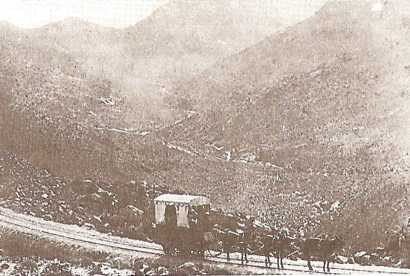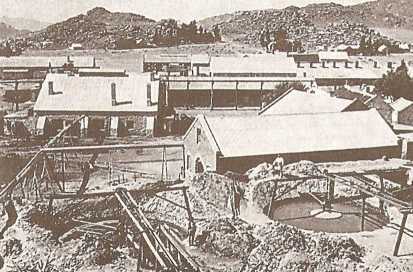
 Home
Page Back
Ground History Mining
Regions The
Postcards The
Tokens Links
Bibliography
Acknowledgements
Site
Forum Cards
& Tokens Classified Ads. Guest
Book Updates
& News Contact
The Site
Home
Page Back
Ground History Mining
Regions The
Postcards The
Tokens Links
Bibliography
Acknowledgements
Site
Forum Cards
& Tokens Classified Ads. Guest
Book Updates
& News Contact
The Site
 Home
Page Back
Ground History Mining
Regions The
Postcards The
Tokens Links
Bibliography
Acknowledgements
Site
Forum Cards
& Tokens Classified Ads. Guest
Book Updates
& News Contact
The Site
Home
Page Back
Ground History Mining
Regions The
Postcards The
Tokens Links
Bibliography
Acknowledgements
Site
Forum Cards
& Tokens Classified Ads. Guest
Book Updates
& News Contact
The Site


O'okiep & Port Nolloth
Location: North West Cape formerly Namaqualand (View location on map)
Minerals Worked: Copper
Principal Mines: Okiep, Spektakel, Nababeep, Concordia plus the export terminal at Port Nolloth.
Background History:
The Okiep mine is is situate about 3 miles north of Springbok and is one of the largest and oldest in this once famous and copper rich district of Namaqualand.
Dutch colonialists discovered the Okiep deposits in 1685, although the indigenous Africans may have previously worked copper there for several hundred years. The first mine to be opened by Europeans in South Africa was located in the Okiep district, and the first South African mining company was formed here in 1852 to mine the copper deposits. Other notable "firsts" for this mining district include the first South African geological report and geological map both of which describe and depict the Namaqualand copper fields.
The Blue Mine, on the outskirts of Springbok, was the first mine to be sunk in the district (1852). Initially, numerous small companies were active in the area. Phillips & King were the first mine operators in the district, working the Springbokfontein deposit. This company also owned the Spektakel, Nababeep and Okiep Mines. Eventually the Cape Copper Company took over and managed the Nababeep, Okiep, and Spektakel Mines, while the Namaqua Copper Company worked in the Concordia area, north-east of Okiep.
The first records of the Okiep mine are dated 1856, when a shaft with a "splendid show of copper" can be found mentioned. By the end of that year the shaft was 12 meters deep. In 1864 a small engine was erected which operated the pumps and roll crushers, and later a whim engine was installed. In the 1860's Okiep became the most important mine of the Cape Copper Company.
In 1866 a narrow gauge railway line was built to Port Nolloth on the coast. This line was primarily used to convey the partially smelted copper matte to the coast from where it was exported for further refining in South Wales. Because there was insufficient supplies of water to operate steam locomotives on this line the service was pulled by mules until as late as 1890.

The mule train between O'okiep Mine & Port Nolloth c.1880
By 1873 the Okiep Mine was 116 meters deep, and large quantities of water had been encountered. A breakdown of the pump caused the lower levels to flood, disrupting operations. This mishap prompted the directors to purchase a 30 inch diameter Cornish beam pumping engine.
The following account of the mine comes from a publication of the Colonial Office of the Cape of Good Hope and is dated 1878;
The present annual production of O'okiep is 12,000 tons of ore, averaging 32 per cent (copper). The number of persons employed in the mine is as follows: 56 miners, 31 mechanics, 716 labourers (men, women and children), 13 overseers, total 816. A railway, 93 miles in length, has been constructed by the Cape Copper Mining Company, connecting the O'okiep mine with Port Nolloth, and giving employment to 7 station masters, 10 conductors, 26 platelayers, 38 mechanics, 17 boatmen, 330 labourers, total 428.
Machinery, such as ore-crushing mills, pumps, Nasmyth hammers, cupola furnaces, steam engines etc., of a very modern type has been erected at the mines and port, necessitating continuous employment of a large number of high-class mechanics. Several trial mines are being worked by the Cape Copper Mining Company in this district, and 23 miners and 37 labourers are employed in them. The total number of people employed on all the works is 1,304. There are 40 horses and 350 mules used in carrying on the work connected with the mines and the railway. The forage required for these animals is 987 tons oats and rye, and 166 tons oat hay, which it is impossible to obtain in Namaqualand, and it therefore has to be imported from the Berg River district or elsewhere.
By 1882 the mine was at a depth of 208 meters and the 30-inch Cornish pump was proving insufficient to handle the water. A second 50-inch Cornish pump, designed by John Hocking and built by Harveys of Hayle, was therefore obtained. As far as is known, this pump is the only complete Cornish pump remaining in the Southern Hemisphere.

O'okiep Mine ore dressing floors c.1890
Production by the Cape Copper Company ceased in 1919 as a result of the post-Great War economic slump. Okiep soon became a ghost town. The operations of the Namaqua Copper Company continued for slightly longer. Its mines finally closed in 1931. The O'okiep Copper Company Limited was later formed in 1937 and by 1939 it had acquired the assets of both the Cape Copper Company and the Namaqua Copper Company.
Fluctuating copper prices, coupled with a remote and hostile setting, have resulted in varying degrees of success and failure in the 150 year modern history of the Okiep district mines. Derelict and abandoned mining apparatus, some imported from Cornwall, can still be seen scattered around at a few of the old mines.

A Cornish Beam Engine House on the site of Okiep Mine.
The Medals
During the Second Anglo-Boer War in January 1901 Boer forces, under General Jan Smuts, invaded the then Cape Province. The Colonial Governor of the Cape, Sir Alfred Milner, dispatched Lieutenant Colonel Shelton to Namaqualand with orders to protect the copper mines located at Okiep together with the railway which linked them to the harbour at Port Nolloth.
To boost his meager forces Shelton recruit both local white and black miners to protect the mining district. Shelton’s forces also employed additional local coloured men as scouts, intelligence agents, messengers, dispatch riders and as transport riders. Those coloured civilians who remained on the farms and mission stations also provided the British troops with food, cattle and horses.
The Boer invaders soon penetrated Namaqualand and made their presence felt with casualties being taken on both sides. By 3rd April 1902 general Smuts’ Boer Commandos had surrounded Okiep and besieged the town. During the siege local miners assisted Shelton’s troops and together they successfully fortified and defended the town. On 4th May 1902 a British relief column arrived from Port Nolloth and ended the siege.
After the war ended the British government awarded the Queen's South Africa medal to all those regular troops that had seen active service in Namaqualand during the war. The black and coloured defenders of Okiep were excluded from these awards. However, the Cape Copper Company awarded their own medals to all the defenders of their property, regardless of race. The bulk of these medals were struck in bronze and were issued to the rank and file of the military and civilian defenders of the town. Further versions of the medal were issued in silver. These was reserved for higher ranking mine officials and regular military servicemen who had taken part in the defense.
For further details plus an image of the medals click the image below.
Few postcards are known for this mining area.
| "Thumbnail" Images (Note 1) | Card Title or Description | Card Ref. No. |
 |
Port Nolloth Jetty, Sowing Method of Loading Copper Ore. | PC112 |
 |
O'okiep - Mine, Namaqualand. | PC188 |
Notes:
1) For further information and enlarged views of each postcard click on any one of the above images.